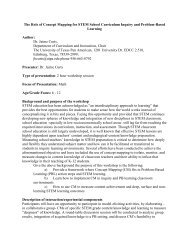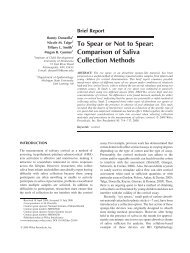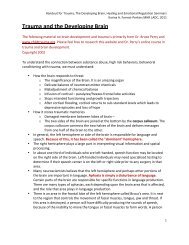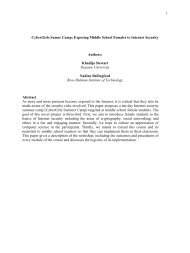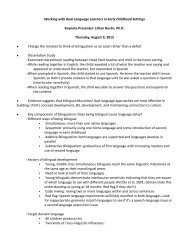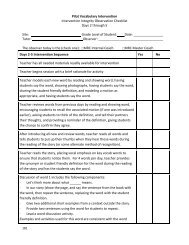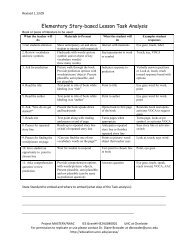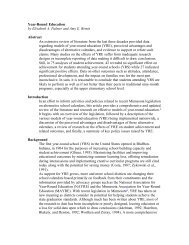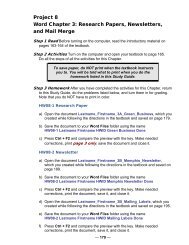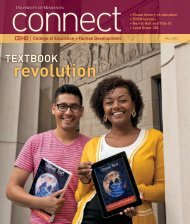Introduction to Positive Ways of Intervening with Challenging Behavior
Introduction to Positive Ways of Intervening with Challenging Behavior
Introduction to Positive Ways of Intervening with Challenging Behavior
Create successful ePaper yourself
Turn your PDF publications into a flip-book with our unique Google optimized e-Paper software.
Physical Restraint...<br />
an emergency procedure<br />
This Tip Sheet has been developed <strong>to</strong> assist teachers and parents in providing the best possible educational<br />
opportunities <strong>to</strong> students <strong>with</strong> emotional and behavioral disorders. This Tip Sheet was published by the Institute<br />
on Community Integration, College <strong>of</strong> Education, University <strong>of</strong> Minnesota, Minneapolis and was authored by<br />
Kareen Smith <strong>of</strong> the Institute.<br />
<strong>Introduction</strong><br />
Physical restraint is a procedure <strong>with</strong> which a person uses his or her body <strong>to</strong> effectively and immediately control<br />
or immobilize another. It may sometimes be necessary <strong>to</strong> physically restrain a student in order <strong>to</strong> protect the<br />
safety <strong>of</strong> staff and students.<br />
It is also a procedure which has <strong>of</strong>ten been misapplied and overused, and it has led <strong>to</strong> lawsuits contending the<br />
violation <strong>of</strong> student constitutional rights. For these reasons, it is important <strong>to</strong> examine the risks <strong>of</strong> physical<br />
restraint, <strong>to</strong> establish when it is or is not appropriate, and how the need for it can be prevented.<br />
What is the appropriate use <strong>of</strong> physical restraint?<br />
The only appropriate use <strong>of</strong> physical restraint when working <strong>with</strong> students <strong>with</strong> emotional and behavioral<br />
disorders is <strong>to</strong> prevent a student from injuring him- or herself or others, or from damaging valuable property. It<br />
should be used only for protection. For example, if an angry student begins <strong>to</strong> physically assault another student<br />
or attempts <strong>to</strong> knock over a television-VCR stand, physical restraint would be appropriate. When it is used for<br />
these reasons, it should be done in a way that calms the student and does not frighten or hurt him or her (S<strong>to</strong>ne,<br />
1990).<br />
It is important that a student be given every opportunity <strong>to</strong> control his or her own behavior before physical<br />
restraint is used. Schloss and Smith (1987) give the following steps <strong>to</strong> be followed before resorting <strong>to</strong> physical<br />
restraint:<br />
"(a) verbally instruct the student <strong>to</strong> engage in nonaggressive behavior;<br />
(b) if the student remains in an aggressive posture 3 seconds after the verbal prompt, provide a gentle manual<br />
prompt (e.g., s<strong>of</strong>tly press against the learner's shoulder) and repeat the verbal prompt;<br />
(c) if after 3 additional seconds the student is still in an aggressive posture, physically direct him/her <strong>to</strong> a safe area<br />
using accepted manual restraint techniques;<br />
(d) once restrained in the safe area, provide frequent verbal cues indicating "I can let go <strong>of</strong> you when you are<br />
relaxed;"<br />
(e) once the student has remained relaxed for 3 minutes, the educa<strong>to</strong>r should gradually relinquish physical control<br />
and proceed in educational and therapeutic aspects <strong>of</strong> the behavior management program.<br />
If the student's behavior escalates so rapidly that waiting 3 seconds between steps would be hazardous, manual<br />
restraint should be used immediately."<br />
It is also very important for the teacher <strong>to</strong> maintain a calm and impartial manner when this procedure is<br />
undertaken. Research has shown that this facilitates the efficacy <strong>of</strong> physical restraint, while using a harsh <strong>to</strong>ne,<br />
threatening, or using excessive force causes escalation <strong>of</strong> aggression (Schloss & Smith, 1987).<br />
When should physical restraint not be used?<br />
First and foremost, physical restraint should not be used by anyone who has not been formally trained in its<br />
proper and effective implementation specific <strong>to</strong> dealing <strong>with</strong> students.<br />
Second, it should not be used simply for convenience when dealing <strong>with</strong> challenging behavior. For example,<br />
if Choua asks Josh <strong>to</strong> sit down so that he can see the filmstrip and Josh refuses <strong>to</strong> sit down and starts verbally




